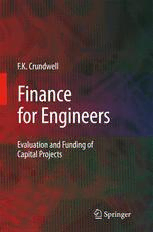
Finance for Engineers: Evaluation and Funding of Capital Projects PDF
Preview Finance for Engineers: Evaluation and Funding of Capital Projects
Finance for Engineers F.K. Crundwell Finance for Engineers Evaluation and Funding of Capital Projects 123 F.K.Crundwell,PhD CMSolutions Wimbledon LondonSW19 UnitedKingdom ISBN 978-1-84800-032-2 e-ISBN 978-1-84800-033-9 DOI10.1007/978-1-84800-033-9 BritishLibraryCataloguinginPublicationData Crundwell,F.K. Financeforengineers:evaluationandfundingofcapitalprojects 1.Capitalinvestments2.Projectmanagement-Finance 3.Engineering-Finance I.Title 620’.00681 ISBN-13:9781848000322 LibraryofCongressControlNumber:2008922273 ©2008Springer-VerlagLondonLimited Apartfromanyfairdealingforthepurposesofresearchorprivatestudy,orcriticismorreview,asper- mittedundertheCopyright, DesignsandPatents Act1988,thispublication mayonlybereproduced, storedortransmitted,inanyformorbyanymeans,withthepriorpermissioninwritingofthepublish- ers,orinthecaseofreprographicreproductioninaccordancewiththetermsoflicencesissuedbythe CopyrightLicensingAgency.Enquiriesconcerningreproductionoutsidethosetermsshouldbesentto thepublishers. Theuseofregisterednames,trademarks,etc.inthispublicationdoesnotimply,evenintheabsenceof aspecificstatement,thatsuchnamesareexemptfromtherelevant lawsandregulations andtherefore freeforgeneraluse. Thepublishermakesnorepresentation,expressorimplied,withregardtotheaccuracyoftheinformation containedinthisbookandcannotacceptanylegalresponsibilityorliabilityforanyerrorsoromissions thatmaybemade. Coverdesign:eStudioCalamarS.L.,Girona,Spain Printedonacid-freepaper 987654321 springer.com ForNataschaandNicholas Preface Investmentdecisionsarecriticalpartofacompany’ssuccess,andcapitalbudgeting is a centraltopic of financial management.However,in contrastto other strategic decisionsinbusiness,decisionsoncapitalprojectsaredecentralized,fromcorporate to divisions, divisionsto operations,from operationsto departments.Engineersat variouslevelswithintheorganizationwhomakeacapitalproposalarecontributing tothestrategicsuccessoftheorganization.Thisbookwillassistengineerstocon- tributestrategicallytotheorganization,sothattheycancontributetothesuccessof theircompanyandcanmakeasuccessoftheircareers. Thepurposeof thisbookis to provideengineersandmanagerswith a working knowledgeofthefinancialevaluationandthefundingofcapitalprojects.Fourmain topicsconcerningcapitalinvestmentarecovered,namely,thecontextofthesedeci- sions,theassessmentoftheirreturns,theassessmentoftheirrisks,andtheirfunding and financing. Engineers have developed the field of engineering economics, and financial managers have developed the discipline of capital budgeting, each with its ownapproachandslightlydifferentterminology.Thisbookborrowsfromboth these disciplines in order to provide engineers with the best possible knowledge aboutcapitalprojects. An important aspect of the approach adopted here is to provide context to the techniques,methodsandconceptsoftheeconomicassessmentofengineeringdeci- sions.Anengineerwhoknowshersubjectisabletocommunicateherideastopeo- pleofdifferentprofessionsandwithdifferenttraining.Anessentialpartofeffective communication is to understand the other person’s paradigm, to know their basic assumptions.As aresult, itisimportanttounderstandthe basicsofdecisionmak- ing,offinancialmanagement,andaccounting.Itisalsoimportanttounderstandthe terminologyusedbydifferentprofessions.PartIofthebookexaminesthesetopics, whichformstheintroductiontotheeconomicassessmentofanengineeringproject. Aprojectisassessedonitseconomicmerits,itsprofitability.PartIIofthebook coversthetechniquesandmethodsofcapitalbudgetingandengineeringeconomics. In-depth case studies demonstrate the application of these techniques to practical situations. vii viii Preface Theassessmentoftheeconomicmeritsofaprojectusuallyreferstothereturns expected from the project. The cornerstones of finance are risk and return, and it is essentialto addresstherisk of theprojectin a discussionof its merits.The risk is the chance of the expectedreturns not materializing. The types of risk, such as stand-aloneriskandportfoliorisk,fora capitalprojectareexaminedinPartIIIof thisbook. Itisalsoimportanttounderstandthefinancingofaproject,thesourcesoffinance, andthestructureoffinancialarrangementssuchasprojectfinanceandpublic-private partnerships.PartIVofthebookexaminesboththeinternalandexternalsourcesof fundingand the structuring of the financial and legal relationshipsthat enable the projecttobebuilt. Intended Readers Thisbookisdesignedforusebothasanundergraduatetextbookforengineersand asareferenceforpractisingengineers.Thematerialassumeslittlepriorknowledge ofengineering,accountingorfinancialmanagement.Itisintendedforuseasatext inundergraduatecoursesoneitherengineeringeconomicsorfinancialmanagement. Itmayalsobeusedinanengineeringdesigncoursewherethefinancialimplications ofdesignareunderdiscussion. Thisbookhasbeen designedto accommodateallbranchesof engineering.Ex- amplesandcase studieshavebeendrawnfromaswidearangeoftheengineering disciplinesaspossible.Forexample,therearecasestudieson,amongstothers,hy- droelectric power, pumping stations, toll roads, mining, processing technologies, andpetroleumproduction.Inaddition,theseexamplescoverdifferentgeographies, such as the US, the UK, Australia and Brazil, so that this book is relevant to the experienceofengineersacrosstheWorld.Anotherimportantexampleofthisisthat the difference in the accounting terminology used in the US and the UK for the preparationoffinancialstatementsisexamined,andatranslationtableisprovided asanAppendix. Educational Package The organization of the themes and the major topics of the book is shown in the diagram.Anumberofdifferentcoursescanbederivedfromthisbook.AnIntroduc- tory course in EngineeringEconomicsmightinclude a topic from the PartI as an introduction,andthenfocusonPartII,inwhichtheevaluationofcapitalprojectsis discussedindetail.AmoreadvancedcourseinEngineeringEconomicscouldselect Chaps. 1 and 4 from Part I, move through Part II and end with Part IV. A course withthetitleofthisbook,FinanceforEngineers,mightcoverthematerialinPartI, Preface ix PartII,Chapter11fromPartIII,andthenendwithPartIV.Anadvancedcoursein FinancialManagementforEngineersmightcoverallthetopics. Sincethisbookisintendedasatextbookandareference,eachchapterincludes numerous worked examples and case studies. Each chapter also includes review questions and tutorial exercises. The review questions are designed to emphasize x Preface theconceptsthatarecoveredinthechapter,whiletheexercisesallowthereaderto practisetheapplicationofthetechniquesdiscussedinthechapter.Workedsolutions toalmostalloftheexercisesareincludedinanAppendix. Spreadsheetsolutionsof all the questionsand the case studies presented in the book can be obtained from the website (www.springer.com/978-1-84800-032-2). These solutions providelearners and facilitators with hands-on material to ensure amorethoroughunderstandingofthematerial.PowerPointslidesfortheswiftde- velopmentofcoursematerialarealsoavailableonthewebsite. AdetailedglossaryoftheimportanttermsusedisalsoprovidedasanAppendix. Acknowledgements Soon after starting my engineering consulting practice, I happened to meet Dr Wolter te Riele on campus. He suggested that I run a course on finance and eco- nomicsforengineers.Severalhundreddelegateswithanengineeringtraininghave attended my courses, including young professionals starting their careers, com- panyCEOs, andMBA graduates.Thisbookisaculminationofthatsuggestionof Wolter’sandIwouldliketothankhimforit.Inaddition,anumberofpeopleencour- aged me to write this book,and pressed me to finish it. KevanFordand Natascha wereprominentinthisregard,andIexpressmyappreciation. IwouldliketothankHazelMoller,DerynPettyandparticularlyNataschaUber- bacherforreadingandcorrectingthemanuscript. FrankCrundwell Contents ListofAbbreviations ...............................................xxiii PartI Foundations 1 AnOverviewoftheEvaluationandFinancingofCapitalProjects ... 3 1.1 EvaluationandFundingofProjects .......................... 3 1.2 ProjectFinancials ......................................... 4 1.3 EvaluatingtheProjectBasedonFreeCashFlow ............... 8 1.4 Profit (or Earnings) is Not Required for the Assessment oftheProject............................................. 11 1.5 InvestmentDecisionPrecedestheFinancingDecision........... 11 1.6 PastExpensesareExcludedfromtheProjectFinancials ......... 12 1.7 AssessmentoftheRiskoftheProject ........................ 12 1.8 FinancingofaCapitalProject............................... 13 1.9 Summary ................................................ 14 1.10 LookingAhead ........................................... 16 1.11 ReviewQuestions......................................... 16 1.12 Exercises ................................................ 17 2 TheTheoryandPractice ofDecision-makingConcerningCapitalProjects .................. 19 2.1 Introduction.............................................. 19 2.2 Cost-benefit Analysis, Engineering Economics andCapitalBudgeting ..................................... 19 2.3 PerspectivesfortheAssessmentofProjects ................... 22 2.4 EnhancingValueforInvestors............................... 23 2.5 BusinessContext.......................................... 24 2.5.1 FinancialStewardshipWithinaBusiness .............. 24 2.5.2 SourcesandUseofFunds........................... 25 2.5.3 InvestmentandFinancingDecisionsWithintheBusiness 27 2.5.4 EvaluationofInvestmentOpportunities ............... 28 xi xii Contents 2.6 BusinessDecision-making.................................. 29 2.7 AFrameworkforDecision-making .......................... 31 2.7.1 StepsintheDecision-makingProcess................. 31 2.7.2 Frame:theDecisionContextandPossibleAlternatives .. 32 2.7.3 Evaluate:theAssessmentofAlternatives BasedonCriteria.................................. 34 2.7.4 Decide:theActofDecision-making .................. 35 2.8 ThePracticeofDecision-makingforCapitalProjects ........... 36 2.8.1 ClassificationofCapitalProjects .................... 36 2.8.2 RelationshipBetweenProjects....................... 36 2.8.3 DecisionAuthorityforCapitalProjects ............... 37 2.8.4 CaseStudy:SmallProject........................... 38 2.8.5 CaseStudy:LargeProject........................... 40 2.9 Summary ................................................ 42 2.10 LookingAhead ........................................... 43 2.11 ReviewQuestions ........................................ 43 2.12 Exercises ................................................ 44 3 FinancialStatements ........................................... 45 3.1 Introduction.............................................. 45 3.2 BusinessProcessandtheDualNatureofTransactions .......... 45 3.2.1 TheDualNatureofTransactions..................... 46 3.2.2 BusinessProcess .................................. 48 3.3 FinancialRecords......................................... 49 3.4 AccountingPrinciplesandConventions....................... 49 3.4.1 BusinessEntity ................................... 50 3.4.2 AccrualAccounting................................ 50 3.4.3 HistoricalCost .................................... 51 3.5 FinancialStatements....................................... 52 3.5.1 BasicTransactionsinaBusiness .................... 52 3.5.2 IncomeStatement ................................. 55 3.5.3 BalanceSheet..................................... 60 3.5.4 CashFlowStatement............................... 62 3.6 Depreciation ............................................. 65 3.7 TheInteractionBetweentheFinancialStatements .............. 69 3.8 RelationshipBetweentheFinancialStatements andtheProjectCashFlows ................................. 71 3.9 CaseStudy:SantaAnnaHydroelectricPowerScheme .......... 72 3.9.1 ProjectFinancials ................................. 72 3.9.2 IncomeStatement ................................. 74 3.9.3 CashFlowStatement............................... 75 3.9.4 BalanceSheet..................................... 76 3.10 ExaminingtheBusinessRisks .............................. 77 3.11 CaseStudy:ApexFoods ................................... 78 3.12 RatioAnalysisandFinancialTrees........................... 83
